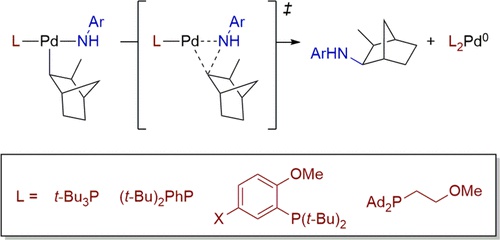Reductive Elimination from Phosphine-ligated Alkylpalladium(II) Amido Complexes to Form sp3 Carbon-Nitrogen Bonds

We report the formation of phosphine-ligated alkylpalladium(II) amido complexes that undergo reductive elimination to form alkyl-nitrogen bonds and a combined experimental and computational investigation of the factors controlling the rates of these reactions. The free-energy barriers to reductive elimination from t-Bu3P-ligated complexes were significantly lower (ca. 3 kcal/mol) than those previously reported from NHC-ligated complexes. The rates of reactions from complexes containing a series of electronically and sterically varied anilido ligands showed that the reductive elimination is slower from complexes of less electron-rich or more sterically hindered anilido ligands than from those containing more electron-rich and less hindered anilido ligands. Reductive elimination of alkylamines also occurred from complexes bearing bidentate P,O ligands. The rates of reactions of these four-coordinate complexes were slower than those for reactions of the three-coordinate, t-Bu3P-ligated complexes. The calculated pathway for reductive elimination from rigid, 2-methoxyarylphosphine-ligated complexes does not involve initial dissociation of the oxygen. Instead, reductive elimination is calculated to occur directly from the four-coordinate complex in concert with a lengthening of the Pd–O bond. To investigate this effect experimentally, a four-coordinate Pd(II) anilido complex containing a flexible, aliphatic linker between the P and O atoms was synthesized. Reductive elimination from this complex was faster than that from the analogous complex containing the more rigid, aryl linker. The flexible linker enables full dissociation of the ether ligand during reductive elimination, leading to the faster reaction of this complex.
Read more on publisher's site.